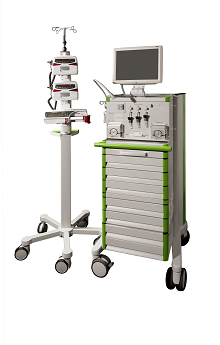Ultra-rapid insulins in glucose clamp trials
Euglycemic glucose clamps have been widely accepted as a standard method for describing the time-action profiles of insulins for many years, and clamp results are required by regulatory authorities in the development of new insulin preparation.[1];[2]
The basic principle of a glucose clamp experiment is simple: A patient’s blood glucose (BG) is kept at a constant, predefined level after giving a test dose of insulin. This is achieved by infusing glucose intravenously at a variable rate. Close monitoring of BG levels and frequent adjustment of the glucose infusion rate (GIR) are essential for maintaining the target glucose level (or ‘clamp level’) with as little deviation as possible. The metabolic effect of the test insulin can be quantified by the GIR, and the course of the GIR curve over time provides an estimate of the time action profile. Usually, highly standardized experimental settings are used in clamp trials: Patients are required to remain fasted and rested, thereby minimizing many potential confounding effects, including food intake, physical activity and interference of concomitant antidiabetic medication. As a result, differences in metabolic properties of insulin can be detected with relatively small sample size. Moreover, this method enables standardized testing over a wide range of insulin doses with a substantially reduced hypoglycemia.
The metabolic effect of the test insulin can be quantified by the GIR, and the course of the GIR curve over time provides an estimate of the time action profile. Usually, highly standardized experimental settings are used in clamp trials: Patients are required to remain fasted and rested, thereby minimizing many potential confounding effects, including food intake, physical activity and interference of concomitant antidiabetic medication. As a result, differences in metabolic properties of insulin can be detected with relatively small sample size. Moreover, this method enables standardized testing over a wide range of insulin doses with a substantially reduced hypoglycemia.
Manual versus automated clamps
A ‘manual’ clamp setting usually involves frequent blood sampling (usually every 3-10 minutes) and adjustments of GIR based on experience and judgement of the investigator. In contrast, a number of devices including the Biostator or, more recently, Profil’s proprietary device ClampArt have been developed to enable ‘automated’ glucose clamp procedures.[3];[4] These devices rely on continuous BG monitoring, and more frequent (usually once per minute) adjustment of GIR based on predefined algorithms. Using automated clamp devices in glucose clamp trials seeks to overcome some limitations of manual clamp procedure: Most notably, a potential for an investigator bias.

Facing new challenges: From rapid to ultra-rapid acting insulins
Many recent developments in the field of novel insulins have focused on new formulations or routes of administration of rapid acting insulin which are intended to achieve a faster onset of action and a more pronounced early activity compared to previously available insulin products.[5],[6],[7],[8] Such “ultra-rapid” acting insulins may potentially offer patients with diabetes a more ‘physiological’ treatment option and help them to better cover prandial insulin requirements.
Keeping clamp technique up to speed: Some key aspects for clamp conduct
Testing ultra-rapid acting insulins in a euglycemic clamp procedure can, however, be very challenging: Adjusting GIR correctly is often difficult during the early, dynamic part of insulin activity, and close monitoring by experienced staff is required. Choosing the right GIR is not just relevant for safety reasons, but it is also essential to ensure that the metabolic effect of the insulin can be estimated correctly: If the rate is too high this will lead to BG levels above target and lead to an overestimation of the metabolic effect. Correspondingly, an underestimation of insulin activity would result from a GIR that is too low.
There are several key aspects of the clamp procedure that are critical for ensuring an optimal clamp quality in studies testing ultra-rapid insulins:
Monitoring glucose levels closely enough
Onset of action is often assessed as an important pharmacodynamic endpoint for rapid acting insulins, because of its potential clinical relevance for any prandial insulin. Onset of action can be defined as the time from dosing until an initial BG drop by 5 mg/dL occurs, indicating the start time of a substantial glucose lowering effect. In a manual clamp procedure, capturing this time point correctly can be difficult, even with blood sampling as frequent as every few minutes. In contrast, automated clamp devices with a continuous monitoring of venous BG usually report one value per minute. This enables detection of relatively small differences of onset of action between different insulin products.
From blood sample to adjusting the glucose infusion: Minimizing the lag
GIR should be adjusted as soon as possible whenever there is a change in metabolic activity. The time required for blood sampling, glucose measurement and adjustment of infusion rates should therefore be kept as short as possible. Notably, when metabolic activity increases very fast during the initial part of insulin action, substantial deviations from target can develop within few minutes unless GIR is adjusted sufficiently.
In a manual clamp setting, the time from blood sampling to adjustment of the infusion rate may vary, depending on the devices that are used, as well as the number and experience of the staff involved in the conduct of the experiment.
ClampArt’s glucose monitoring system is based on continuous sampling of venous blood by means of a diluminal catheter positioned in an IV cannula. Heparinized blood is transported through a tubing system to a sensor located in the ClampArt device itself. At a blood sampling rate of approximately 2 ml/hr, there is a delay of approximately 2 minutes from sampling to measurement. The median BG during the last 60 seconds is recorded once per minute. Future developments may explore options how to further shorten this interval, e.g. by using higher blood sampling rates for short clamp procedures, or by reporting median BG of shorter intervals (<1 minute).
Choosing the right glucose infusion rate
Obviously, quality may vary in manual clamps clamp procedures depending on the investigator’s choices of GIR adjustments. In contrast, clamp quality of an automated clamp procedure is determined by the ability of an implemented algorithm to maintain BG at target level.
ClampArt was originally programmed using the established Biostator algorithm for the calculation of GIR.[9] While this algorithm was successful in maintaining average BG levels close to a predefined target level relatively high oscillations as well in GIR as in BG occurred which could potentially lead to transient over- or underestimation of metabolic effects. An improved algorithm has been developed and implemented in ClampArt, which significantly reduced the amplitude of the oscillations in both BG and GIR during a clamp test of rapid-acting insulin.[10]
Avoiding bias and monitoring quality
Clamp experiments with ultra-rapid insulins can be quite prone to an investigator bias, in particular if the investigator is not sufficiently blinded for the study treatment. Blinding may, however, be difficult in some situations, for example when comparing different routes of administration or different devices. The risk of investigator bias will probably be higher for manual clamp procedures than for automated clamp procedures, because it cannot be excluded that an investigator’s choice of GIR will be driven rather by the expected than the observed insulin effect: If this results in (too) high initial infusion rate and BG levels above target, this can again lead to an overestimation of early insulin action. The risk for a misinterpretation underlines why it is important to always report BG results together with the GIR. Moreover, meaningful measures of clamp quality should be assessed and reported on a routine base.4
References:
[1] DeFronzo, Ralph A., et al. "Glucose clamp technique: a method for quantifying insulin secretion and resistance." American Journal of Physiology-Endocrinology and Metabolism 237.3 (1979): E214.
[2] European Medicines Agency. Guideline on clinical investigation of medicinal products in the treatment or prevention of diabetes mellitus. CPMP/EWP/1080/00 Rev. 1.
[3] Clemens, A. H., P. H. Chang, and R. W. Myers. "The development of Biostator, a Glucose Controlled Insulin Infusion System (GCIIS)." Hormone and metabolic research= Hormon-und Stoffwechselforschung= Hormones et metabolisme (1977): 23.
[4] Benesch, Carsten, et al. "How to assess the quality of glucose clamps? Evaluation of clamps performed with ClampArt, a novel automated clamp device." Journal of diabetes science and technology 9.4 (2015): 792-800.
[5] Heise, Tim, et al. "Pharmacokinetic and pharmacodynamic properties of faster-acting insulin aspart versus insulin aspart across a clinically relevant dose range in subjects with type 1 diabetes mellitus." Clinical pharmacokinetics 56.6 (2017): 649-660.
[6] Andersen, Grit et al. "The ultra-rapid biochaperone insulin lispro (BC LIS) shows a faster onset of action and stronger early metabolic effect than insulin lispro (LIS)." ADA2014 (2014): 13-17.
[7] Pettis, Ronald J., et al. "Intradermal microneedle delivery of insulin lispro achieves faster insulin absorption and insulin action than subcutaneous injection." Diabetes technology & therapeutics 13.4 (2011): 435-442.
Baughman, Robert A., et al. „Technosphere Insulin Inhalation Powder (TI) Displays Earlier Onset and Shorter Duration than Insulin Lispro (Lispro)”
[8] Klonoff, David C. "Afrezza inhaled insulin: the fastest-acting FDA-approved insulin on the market has favorable properties." (2014): 1071-1073.
[9] Clemens, A. H., D. L. Hough, and P. A. d'Orazio. "Development of the Biostator Glucose clamping algorithm." Clinical chemistry28.9 (1982): 1899-1904.
[10] Kuhlenkötter, Mareike, Tim Heise, and Carsten Benesch. "Improved Algorithm for Automated Glucose Clamps." Diabetes technology & therapeutics 19.2 (2017): 124-130.




